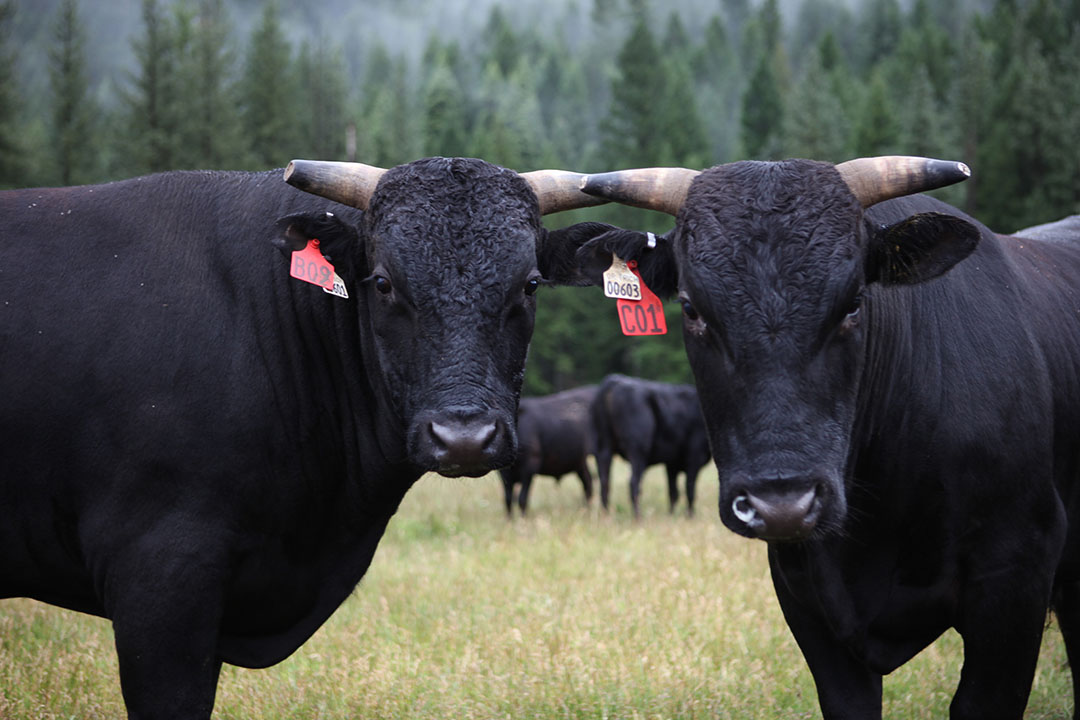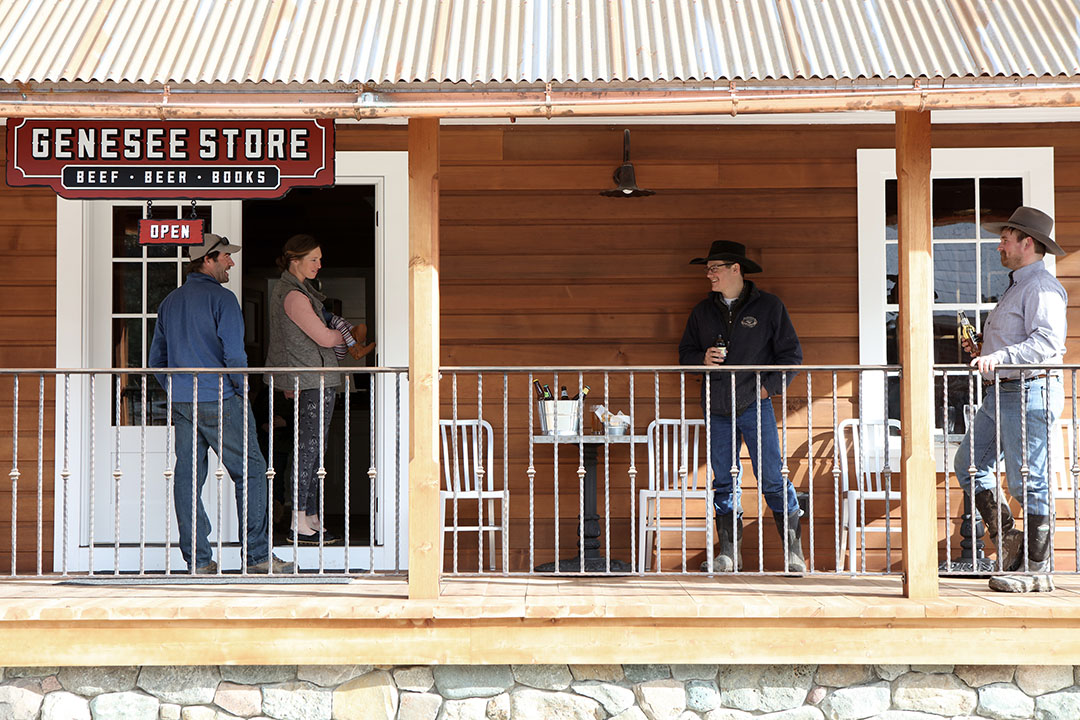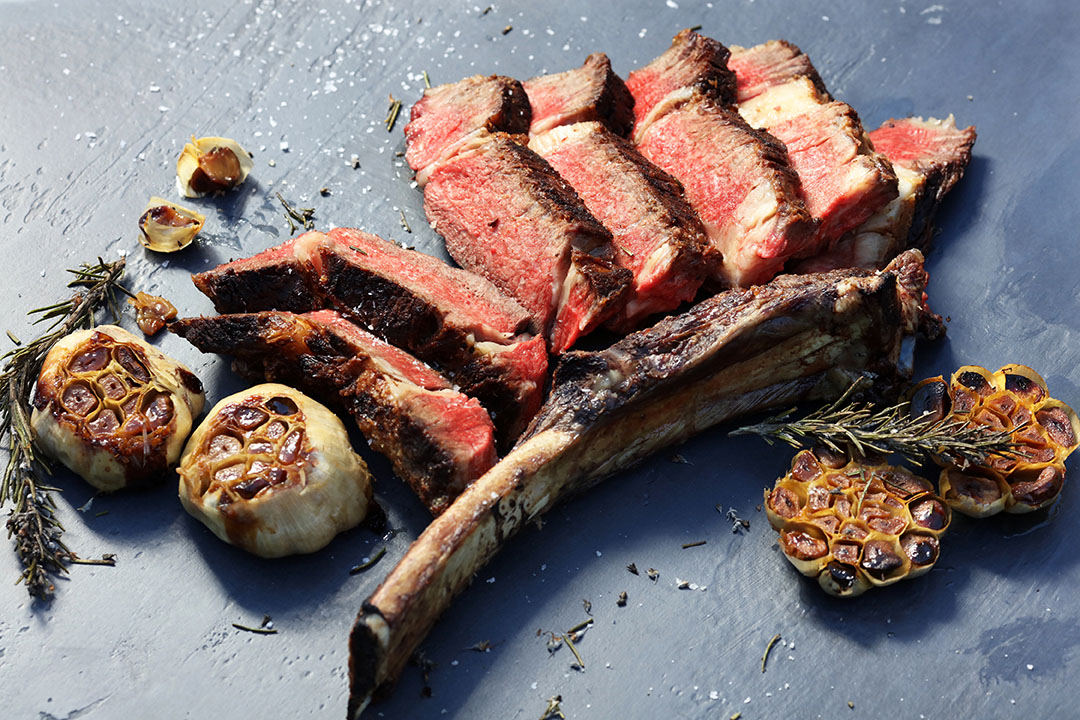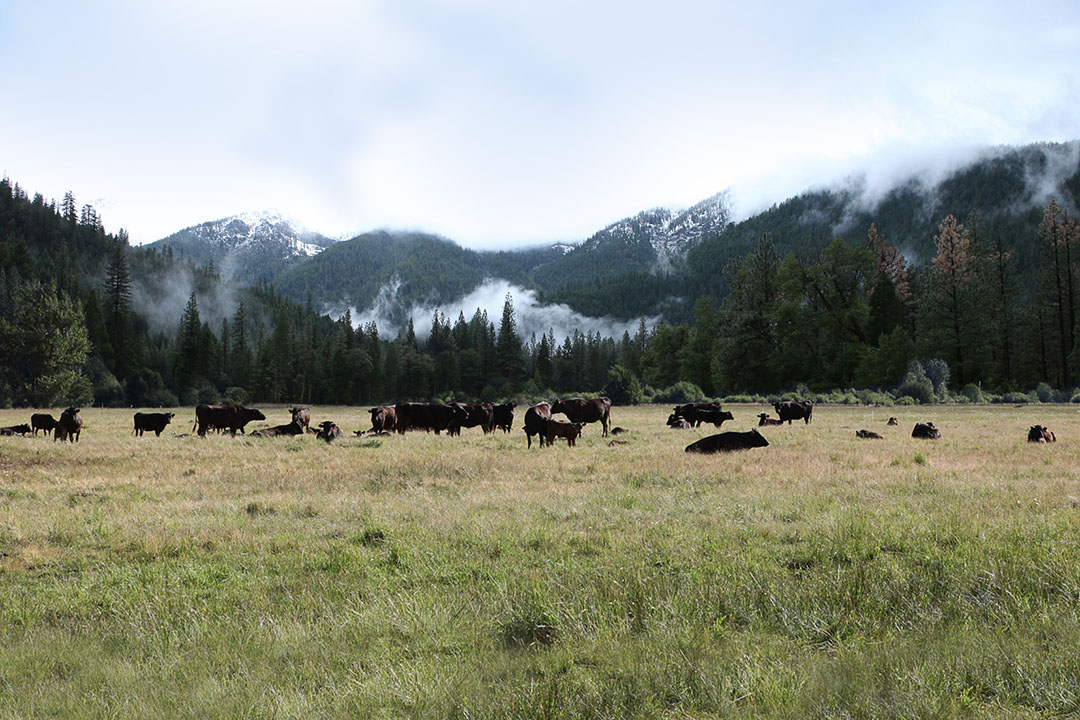Family-run ranch raises grass-fed wagyu in the High Sierra.
In the lush Genesee Valley at 3,500 feet elevation, black-horned cows graze in chest-high grass, with the granite peaks of the Sierra Nevada looming behind them. Surrounded by the Plumas National Forest, roughly 30 miles southeast of Lake Almanor, the historic Genesee Valley Ranch is a family-run operation with roots dating back to California’s Gold Rush. Today, the Palmaz family — known for its eponymous winery in Napa Valley — is taking the same fusion of tradition and technology used to create their estate cabernet to raise, harvest, and sell their grass-fed wagyu beef.
“Let’s make beef worthy of our wine,” says Florencia Palmaz, co-founder and partner of Palmaz Vineyards, about her family’s mission of revitalizing Genesee Valley Ranch. “Let’s take the same model of what we call estate growing in the wine industry — our wine doesn’t leave the property, not for a minute, until it’s fully finished and ready for consumers — and take on that task in the beef world. We call it ‘estate beef.’”

The Palmaz family, a clan characterized by hard work and ingenuity, wouldn’t have it any other way. Originally from Argentina, Julio and Amalia moved to the United States in 1978 with baby Florencia. Julio worked as a doctor in Northern California and then Texas, where he went on to develop the first balloon expandable vascular stent to receive U.S. Food and Drug Administration approval. Amalia, a third-generation rancher who managed her family’s mining concern prior to moving to America, would later start a grass-fed fallow deer ranch with Florencia in the Texas Hill Country, supplying venison to restaurants run by the likes of Wolfgang Puck. The mother-daughter duo also founded GoodHeart Brand Specialty Foods, which produces ready-to-eat meals for retail sale.
In the late 1990s, the family purchased a vineyard in Napa Valley, established in 1881, that hadn’t produced wine since the ratification of the 18th Amendment in 1919. The Palmaz family — including son Christian and his wife, Jessica — brought the vineyard back to life not only with a keen taste for quality wine, but also with an eye toward technology. Christian, a former computer engineer turned CEO of the winery, coded a proprietary program, Vineyard Infrared Growth Optical Recognition (VIGOR), that uses aerial imagery to track soil moisture and overall vine health. Another system he developed measures different variables during fermentation. The winery, built into an 18-story cavern in the base of Mount George, utilizes “gravity flow” — a gentler method for moving wine through the production process — in its state-of-the-art, 91,000-square-foot facility.

But with the whole family residing at the vineyard where they worked and hosted tours and tastings, they were in need of a retreat.
“We found this piece of land in the Sierra and were enamored because it reminded us of those plains in Argentina. Typical us, we’re too energetic. We can’t help it,” Florencia says with a laugh. “For us, idle land is not sustainable. If we just used it as a vacation home, some generation down the line is going to sell it. That’s not the plan. So we started the cattle operation.”
Raise the Steaks
With the goal of producing the highest quality meat possible, the Palmaz family landed on raising wagyu, a Japanese beef cattle breed originally used as draft animals for agriculture production. Due to their working roots, natural selection, over time, favored the animals with more endurance due to intramuscular fat cells — what we see as the coveted marbling in steaks — that provided a readily available energy source for the cows.
“There are very few, high-prime, 100 percent grass-fed processors in the world. When customers think about wagyu beef, their minds immediately go to kobe,” Florencia explains. “The dirty truth about kobe beef is that it is urban industrial farming. The animals are kept in small concrete pens and fed incredibly unhealthy diets. That doesn’t appeal to us. We’ve got too much pride and too much compassion for the animals.”
The Palmaz family turned to Michele Haskins, a fifth-generation rancher and former heli-rappel wildland firefighter, to run the ranch and create a program that put the well-being of the cows first, not only for the sake of the animals but also for the quality of the final product. The calves wean naturally from their mothers, their horns are left intact, and moving the herd from one field to another is a process free of poking and prodding.
“We look at it like we are farming two things: We’re farming grass, and we’re farming the animals. We rotate the animals on the grass so that they’re actually part of the tilling and regeneration of the field,” Florencia explains. “We only want them to have one bad day.”
Unlike most American beef operations in which calves are sold off to growers and feedlots to plump up on a mostly corn diet, the cows in Genesee Valley eat a variety of grasses for their entire lives on the ranch. Pastures of up to 100 acres divide the 1,600-acre property, irrigated by snowmelt from the surrounding peaks and a gravitational irrigation system finely tuned with the help of the family’s software, VIGOR. Aerial images taken every month are analyzed with the program to show how water spreads across the ranch to optimize usage and to help Haskins determine where to move the cows based on the different grass varieties’ growth cycles.
The result of grass feeding and finishing wagyu cows is beef with an unparalleled flavor and texture.
“You get this amazing, moist, well-marbled beef with a flavor that you just don’t get in any other situation, because [the cows] having fed on these grasses gives a density and almost a minerality to the meat. It does definitely take on a little bit of an olive flavor with a subtle herbaceousness to it,” Florencia explains. “And the fat in grass-fed beef has a higher omega-3 content than non-grass-fed beef. It melts at a much lower temperature, so it’s literally melting in your mouth.”
The team at Genesee Valley Ranch harvests roughly 80 cows a year, which it sells direct-to-consumer through different memberships: a whole-cow offering with six shipments throughout the year of eight to 10 cuts each, a quarterly box, and a single, or “a moo’s bouche,” box with a variety of cuts. À la carte items also can be purchased through the ranch’s website, which shows off the unique variety of cuts taken from each cow, a hybrid of butchery methods in Japan, South America, and the U.S.
Florencia says one of the most delicious cuts is zabuton, “a small muscle in the middle of the shoulder that’s just incredibly marbled. We love to cut it Japanese-style into really thin slices for either yakitori or hibachi.”
Preserve the Past
The Palmaz family fell in love with Genesee Valley for many of the same reasons that its first inhabitants did. Long before the arrival of pioneers, the land was home to the Northern Maidu Tribe, whose members lived in small villages throughout Plumas County. At the confluence of the Grizzly and Indian creeks, one such village was called Yetámato-non.
In 1862, as pioneers continued to travel westward more than a decade after California’s Gold Rush, Edwin D. Hosselkus of Genesee, N.Y., came to the valley. Naming the valley after his hometown, Hosselkus forewent prospecting in favor of ranching and setting up an outpost. Using wood from the surrounding forests, he built a general store and post office called Genesee Store, as well as a granary, creamery, and blacksmithing shop to serve the nearly 5,000 miners who lived in the area.

After purchasing the Genesee Valley Ranch in 2015, the Palmaz family knew they owed it to the community to restore Genesee Store and continue running it as a restaurant. Restoration of the historic building began in 2017 and took three years to complete. Today, the restaurant highlights the ranch’s beef through twists on a variety of cuisines created by chef Nathan Molina.
Each week there’s a new cut of beef on special, ranging from a bavette pinwheel to a two-pound tomahawk. Sample the wagyu in the restaurant’s spaghetti and meatballs or a Wagyu burger sharing bun space with a hoisin-marinated shiitake and grilled scallion/red miso mayo. In Gee’s Noodle Bowl — an ode to Gee Pond Joe, the first cook at the store in 1880 and a Chinese immigrant — house-made bone broth and wagyu beef mingle with rice noodles, crushed kale, mushrooms, and a soft-boiled egg. At Sunday brunch, tuck into a ranch breakfast with two eggs, wagyu bacon, tomato-chipotle salsa, and hash browns (which you could cap off with an order of cast-iron skillet banana bread). Palmaz Vineyards’ cabernet and Chardonnay also are available on the well-curated (and California-heavy) wine menu.
“On the vineyard in Napa, we’ve been producing ultra-premium cabernet for collectors and connoisseurs because that is what Napa Valley does for wine,” Florencia explains. “We wanted to do the same thing for the ranch because we felt like the land was just that special.”
Claire McArthur is a freelance writer who ultimately netted zero dollars for her work on this article given the fact that after crafting it, she quickly went online and purchased several cuts of Genesee Valley Ranch beef. She has zero regrets.
RECIPE
Grilled Wagyu Tomahawk with Salsa Chimichurri
(courtesy of Florencia Palmaz, co-owner, Genesee Valley Ranch in Taylorsville. Serves 2 to 3)

1 tomahawk steak (2 to 3 pounds)
Sea salt and pepper, to season
1 whole garlic
Sprigs of rosemary
Flaked salt, for finishing
Pat tomahawk steak dry with paper towel. Just before grilling, liberally season with salt and pepper.
To cook steak, use either the classic or reverse-sear method.
Classic
Wrap the bone in aluminum foil so it does not burn. Sear steak in a hot, oiled skillet, preferably cast iron, then transfer to the oven and roast for about 5 to 10 minutes at 425 degrees F.
Reverse Sear
The reverse-sear method involves cooking low and slow in the oven at 250 or 300 degrees F, until the meat reaches an internal temperature of 100 degrees F. Then sear in a hot, oiled skillet, preferably cast iron, on the stove top.
For either method, use a meat thermometer. Remove from heat and allow to rest until meat reaches desired temperature: 125 degrees F for rare, 135 for medium-rare, or 145 for medium. Allow steak to rest 5 to 10 minutes before slicing and serving.
Finish with salt flakes and slice against the grain. Serve with garlic, sprigs of rosemary, and salsa chimichurri (recipe below). Pair with Palmaz Vineyard’s Brasas cabernet.
For salsa chimichurri
2 bunches parsley
2 bunches cilantro
10 cloves garlic, finely minced
1 750-milliliters bottle extra-virgin olive oil
2 teaspoons cumin
¼ cup white balsamic vinegar
3 teaspoons crushed red pepper
Sea salt, to taste
Wash and de-stem parsley and cilantro. Place minced garlic, parsley, and cilantro in food processor. While processor is running, add olive oil in a drizzle. Turn off and add cumin, balsamic vinegar, and crushed red pepper. Adjust seasonings and salt to taste.


